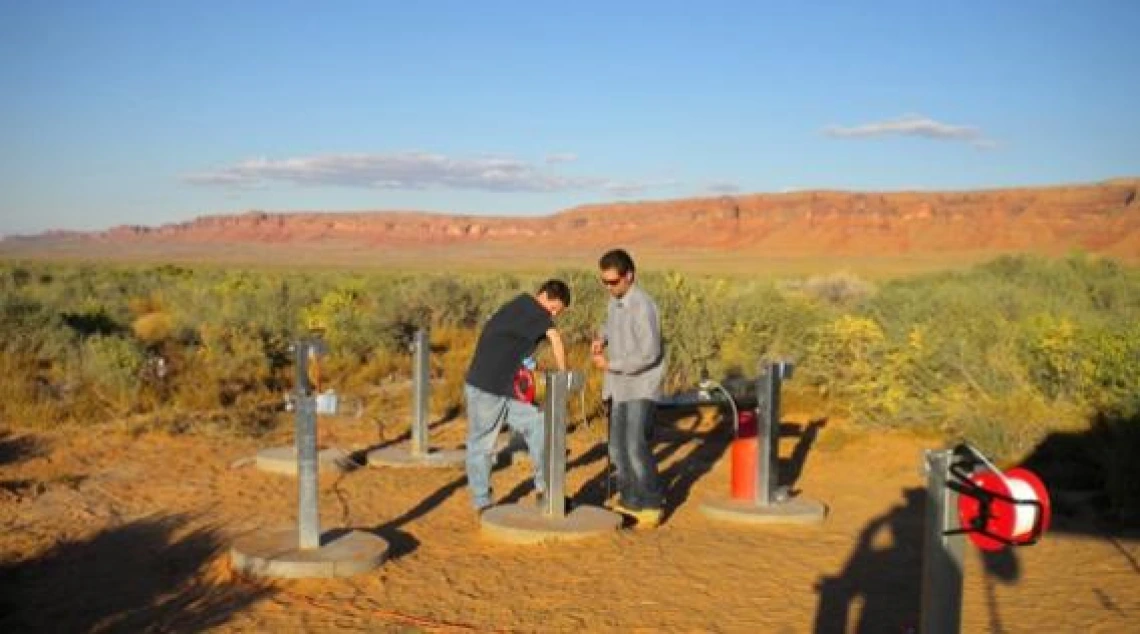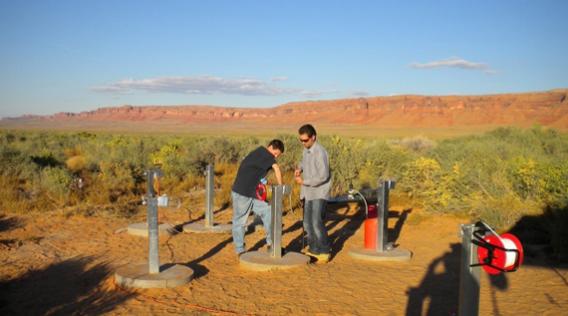Research Update: Brusseau Lab

In-situ Biosequestration for Remediation of Uranium in Groundwater at an Arizona Site
The University of Arizona Superfund Research Program (UA SRP) is leading a collaborative project co-funded by the SRP and US Dept. of Energy to investigate the effectiveness of in-situ biosequestration for treating uranium in groundwater at an Arizona site. The SRP team is comprised of UA SRP researchers Mark Brusseau (lead investigator) Jon Chorover, Jim Field, and UA SRP Director, Raina Maier
 The Problem
The Problem
There are presently few alternatives to pump and treat for remediation of groundwater contaminant plumes resulting from mining activities. Such plumes may contain contaminants such as uranium, arsenic, selenium, and other similar constituents. While permeable reactive barriers (PRBs) have been demonstrated to be an effective method for treating waters containing inorganic contaminants, they are impractical for the deep contaminant plumes common to mining sites in the western US. Alternative remediation technologies are a current focus of research and development. One such alternative is in-situ biosequestration, wherein an electron donating substrate is injected to promote microbial activity and associated sequestration of contaminants (e.g., bioprecipitation, biomineralization, enhanced adsorption). Figure 1 shows how in-situ biosequestration would treat uranium in groundwater.
The Site

The Monument Valley Processing Site is a former uranium mining site located at Cane Valley, Arizona, 15 miles south of Mexican Hat, UT (Figure 2). The site is managed as a Uranium Mill Tailings Radiation Control Act Title I site by the US Department of Energy Office of Legacy Management. Uranium mining at the site occurred from 1943 to 1968. From 1964 to 1968, batch and heap leaching with sulfuric acid solution was used to process an estimated 1.1 million tons of tailings and low-grade ore at the site.
As a result of these activities there is currently a groundwater contaminant plume, approximately 1.5 km long (grey area in Figure 2), with nitrate and sulfate concentrations as high as 600 mg/L and 1500 mg/L, respectively. Concentrations of heavy metals, uranium, and arsenic are relatively low (most values < 10 µg/L) within the study area. One exception is a location near the source area, where elevated uranium (> 200 µg/L) is present (see red circle in Figure 2).
Results of Prior Pilot Tests
 Since 2007, Dr. Brusseau and collaborators have been conducting pilot-scale field tests at the Monument Valley site to investigate the feasibility and sustainability of in-situ bioremediation to treat groundwater contaminated by nitrate and sulfate (Figure 3). The injection of an electron donor induced denitrification and bacterial sulfate reduction, as confirmed by exponential decreases of nitrate and sulfate concentrations in concert with changes in oxidation-reduction potential, redox species, alkalinity, production of hydrogen sulfide, and fractionation of δ15N-nitrate and δ34S-sulfate. The induction of reducing conditions caused a significant decrease in the concentration of uranium in groundwater, demonstrating feasibility of in-situ biosequestration at this site. The finding of greatest significance from this initial study is that a single three-day injection of electron donor produced reducing conditions that were sustained for approximately three years, sequestering uranium the entire time. This is in contrast to other studies that have shown that much more frequent injection of electron donor is required to maintain reducing conditions. Delineating the potential cause(s) of this sustained biosequestration condition at Monument Valley is the focus of the upcoming project, which begins in April 2015.
Since 2007, Dr. Brusseau and collaborators have been conducting pilot-scale field tests at the Monument Valley site to investigate the feasibility and sustainability of in-situ bioremediation to treat groundwater contaminated by nitrate and sulfate (Figure 3). The injection of an electron donor induced denitrification and bacterial sulfate reduction, as confirmed by exponential decreases of nitrate and sulfate concentrations in concert with changes in oxidation-reduction potential, redox species, alkalinity, production of hydrogen sulfide, and fractionation of δ15N-nitrate and δ34S-sulfate. The induction of reducing conditions caused a significant decrease in the concentration of uranium in groundwater, demonstrating feasibility of in-situ biosequestration at this site. The finding of greatest significance from this initial study is that a single three-day injection of electron donor produced reducing conditions that were sustained for approximately three years, sequestering uranium the entire time. This is in contrast to other studies that have shown that much more frequent injection of electron donor is required to maintain reducing conditions. Delineating the potential cause(s) of this sustained biosequestration condition at Monument Valley is the focus of the upcoming project, which begins in April 2015.

